Giraffes Face Threat Of ‘Silent Extinction’
New count shows giraffe numbers have fallen—quietly but drastically—over the last 15 years.
By Vicki Croke
It’s being called a possible “silent extinction†–the massive, yet largely unnoticed decline in numbers of a very quiet species.
According to the Giraffe Conservation Foundation, a new study due to be published next year shows that the population of the world’s tallest land animals has declined by 40 percent over the past 15 years—from 140,000 down to 80,000. As they do with most everything, giraffes have been unobtrusive—even in the way they’ve lost ground.
Julian Fennessy, the head of GCF, told Scientific American:
“Giraffes are the forgotten megafauna. They’re really not getting the attention they deserve.†As a result, he says, “giraffes are in peril.â€
And it’s not just people outside of zoological circles who are in the dark. According to Scientific American:
Surprisingly, even scientists haven’t given much attention to giraffes until the past five or so years. “We’re learning a lot more about their ecology but what we know is still way behind what we know about other species,†says David O’Connor, research coordinator with the San Diego Zoo’s Institute for Conservation Research.
Out of nine recognized subspecies of giraffe, only two are considered endangered. Experts believe, however, that as this new survey data on populations is considered, that will increase.
Across the African continent, the culprits for the decline are the usual suspects: Habitat loss, habitat fragmentation and habitat degradation, human population growth, and poaching, according to the GCF, which is based in Namibia.
“The threat today is civilization, which has been encroaching on their territory for decades,†says Lynn Sherr, a former reporter for ABC News, who now works with the Giraffe Conservation Foundation. “Slaughter of their bodies for items better purchased in the pharmacy or elsewhere has also increased. It is more than wasteful. It is the thoughtless destruction of a precious and unique creature that harms no living being.â€
Sherr, who wrote a book about giraffes, “Tall Blondes,†says the latest giraffe count is cause for alarm. “I cannot imagine a world without giraffes. I hope I never have to.â€
Habitat loss is the main problem, but East and Central Africa have also been hit hard by poaching. According to ABC News:
In Tanzania, Fenessy said the latest word on the street is that consuming giraffe could be a cure for HIV. In a 2010 report written for the Rothschild Giraffe Project, researcher Zoe Muller wrote: “It is believed [in Tanzania] that giraffe brains and bone marrow can cure HIV-AIDS victims,†adding that “freshly severed heads and giraffe bones can fetch prices of up to $140 per piece.â€
“In rural African communities, bush meat not only forms a large part of the diet but also provides an important source of income,†wrote Muller, adding, “Killing a giraffe involves relatively little effort for the amount of meat yielded as a large quarry can be secured with a single gun-shot.”
Giraffes do better facing their natural enemies: they can be hunted by lions and hyenas. But for this, they are well-equipped to defend themselves. The 2,000-pound, 14-to 20-foot-tall animals with hooves the size of dinner plates, can deliver a damaging or even killing kick.
They might not be able to fight back where habitat loss or poaching are concerned, but evidence shows that giraffes are capable of rebounding when given the chance. Niger is one of 21 African countries where the animals can be found. In fact, the subspecies here—the West African or Nigerian giraffe is one of the two types already considered endangered. But things are getting better. According to Newser:
Niger put protections into place for the West African giraffe, a subspecies of the animal, and numbers have risen from 50 to 400. It’s proof that such policies can work if they’re enforced, says the GCR official, who adds that the next few years are critical to giraffes’ long-term survival.
These animals are icons of wild Africa.
“Giraffes are magical, no question about it,†says Sherr. “They are a stately, serene presence in a tumultuous world. An unlikely size and shape that no human artist could have conceived. At once graceful, as they gallop across the plains, and gawky, as they splay their long legs to take a drink. I got hooked more than 40 years ago, on my first trip to Africa, and I have yet to meet a more elegant, gentle individual. Or one with longer eyelashes.â€


